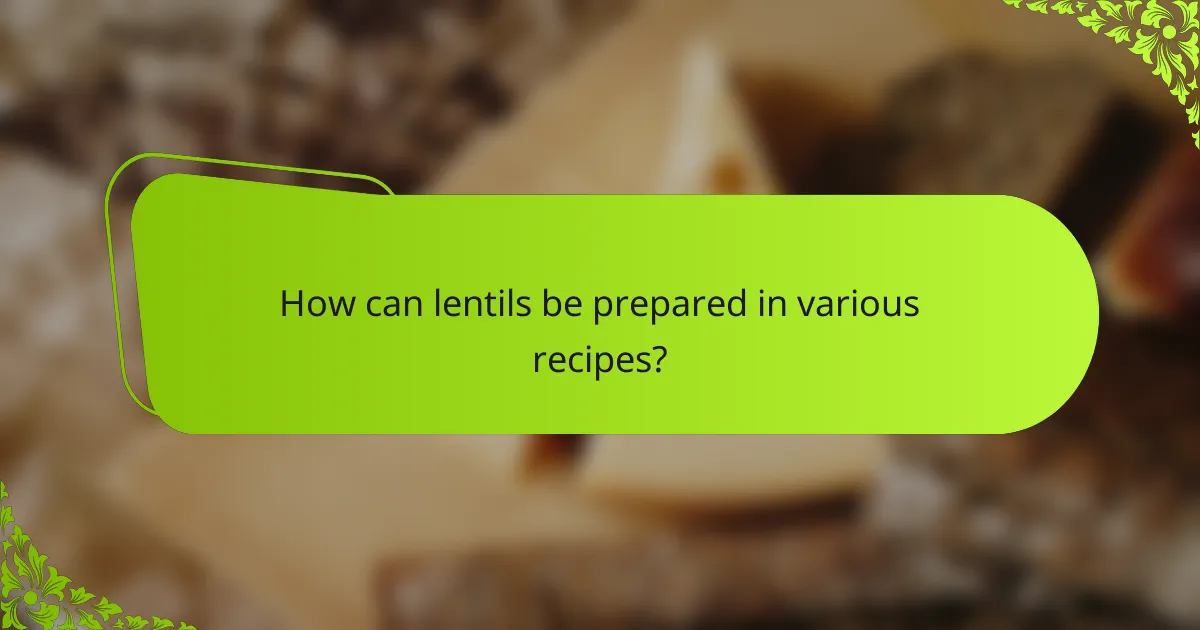
What are Lentil Meals?
Lentil meals are dishes primarily made using lentils as the main ingredient. These meals can be prepared in various forms, including soups, stews, salads, and curries. Lentils are a rich source of plant-based protein, fiber, and essential nutrients. They are also low in fat and have a quick cooking time compared to other legumes. On average, lentils take about 15 to 30 minutes to cook, depending on the variety. Popular lentil varieties include green, brown, red, and black lentils. Each type offers distinct flavors and textures, making them versatile for different recipes. Lentil meals are also known for their health benefits, including improved digestion and heart health.
How are lentils classified in culinary terms?
Lentils are classified in culinary terms based on their color, size, and cooking properties. Common classifications include green, brown, red, yellow, and black lentils. Green lentils are often used in salads and retain their shape well. Brown lentils are versatile and commonly used in soups and stews. Red and yellow lentils cook quickly and tend to break down, making them ideal for purees. Black lentils, also known as beluga lentils, are prized for their caviar-like appearance and firm texture. Each type has distinct flavors and uses in various cuisines.
What types of lentils are commonly used in meals?
Common types of lentils used in meals include green, brown, red, and black lentils. Green lentils are often used in salads and soups. They hold their shape well during cooking. Brown lentils are versatile and commonly found in stews and casseroles. Red lentils cook quickly and are often used in Indian dal dishes. Black lentils, also known as beluga lentils, are used in gourmet dishes due to their unique appearance and flavor. Each type of lentil offers distinct textures and flavors, making them suitable for various recipes.
What nutritional benefits do lentils provide?
Lentils provide significant nutritional benefits, including high protein content, fiber, and essential vitamins. They contain approximately 18 grams of protein per cooked cup. Lentils are also rich in dietary fiber, offering about 15.6 grams per cup, which aids digestion. They are a good source of iron, providing around 6.6 mg per cooked cup, essential for oxygen transport in the body. Additionally, lentils are packed with folate, delivering about 358 mcg per cup, which supports cell division and overall health. They are low in fat, containing less than 1 gram per serving. These attributes make lentils a nutritious choice for a balanced diet.
What is the protein content of lentil meals?
Lentil meals contain approximately 18 grams of protein per cooked cup. This protein content varies slightly based on the type of lentil used. For instance, green and brown lentils typically offer similar protein levels. Red lentils have a slightly lower protein content, averaging around 15 grams per cooked cup. Lentils are also a complete protein source when combined with grains. This makes them an excellent choice for vegetarian and vegan diets.
How does the protein content of lentils compare to other legumes?
Lentils contain approximately 18 grams of protein per cooked cup. This protein content is comparable to other legumes, such as chickpeas and black beans, which offer around 15 grams and 15.2 grams of protein per cooked cup, respectively. However, lentils have a higher protein content than some legumes like peas, which provide about 8 grams per cooked cup. This makes lentils a rich source of plant-based protein. Additionally, lentils are low in fat and high in fiber, adding to their nutritional profile. Their protein quality is also noteworthy, as they contain essential amino acids necessary for human health.
What factors influence the protein content in lentil meals?
The protein content in lentil meals is influenced by several factors. These factors include lentil variety, growing conditions, and processing methods. Different lentil varieties have varying protein levels, with some containing up to 25% protein by weight. The soil quality and climate where lentils are grown also affect their nutritional profile. For example, lentils grown in nutrient-rich soil typically have higher protein content. Additionally, processing methods, such as soaking and cooking, can alter protein availability. Cooking methods that preserve the structure of lentils can help retain their protein content. Research shows that specific varieties and optimal growing conditions can significantly enhance protein levels in lentils.
What are the typical cooking times for lentils?
Lentils typically cook in 15 to 30 minutes. The cooking time varies based on the type of lentils used. For example, red lentils cook faster, usually within 15 to 20 minutes. Green and brown lentils take longer, generally 20 to 30 minutes. Soaking lentils before cooking can reduce the cooking time. Lentils should be cooked until they are tender but not mushy. Cooking times may also vary depending on the desired texture.
How do different varieties of lentils affect cooking time?
Different varieties of lentils significantly affect cooking time. For example, red lentils cook faster, typically within 15-20 minutes. Green and brown lentils take longer, around 30-40 minutes. Black lentils, known as Beluga lentils, require about 25-30 minutes to cook. The size and thickness of the lentils influence this variation. Smaller lentils generally soften quicker than larger varieties. Additionally, the age of the lentils can impact cooking time. Older lentils may take longer to cook compared to fresher ones. Cooking methods, such as soaking, can also reduce cooking time.
What cooking methods can be used for lentils?
Lentils can be cooked using several methods. Common cooking methods for lentils include boiling, pressure cooking, and slow cooking. Boiling involves simmering lentils in water until tender, usually taking 15 to 30 minutes. Pressure cooking significantly reduces cooking time to about 10 minutes, retaining nutrients. Slow cooking allows for deeper flavor development, taking 4 to 6 hours. Each method effectively prepares lentils for various dishes. These methods are widely used in culinary practices, ensuring lentils are versatile and nutritious.

How can lentils be prepared in various recipes?
Lentils can be prepared in various recipes through boiling, sautéing, and baking. Boiling lentils typically takes 15 to 30 minutes, depending on the type. Sautéing lentils involves cooking them with vegetables and spices for added flavor. Baking lentils can be done in casseroles or combined with other ingredients. Lentils can also be used in soups, stews, and salads. Each method allows for different textures and flavors. For example, boiled lentils are soft, while sautéed lentils retain some firmness. They are versatile and can absorb various seasonings. This adaptability makes lentils a popular choice in many cuisines.
What are some popular lentil meal recipes?
Popular lentil meal recipes include lentil soup, lentil salad, and lentil curry. Lentil soup combines lentils with vegetables and spices, creating a hearty dish. Lentil salad features cooked lentils mixed with fresh veggies and a dressing. Lentil curry incorporates lentils with coconut milk and spices for a flavorful meal. Other recipes include lentil tacos and lentil burgers, which offer creative ways to enjoy lentils. Each recipe highlights lentils’ versatility and nutritional benefits.
How can lentils be incorporated into soups and stews?
Lentils can be incorporated into soups and stews by adding them during the cooking process. They should be rinsed and sorted to remove any debris. Whole lentils can be added to the pot along with other ingredients. They typically require 20 to 30 minutes of simmering to cook thoroughly. Red lentils break down faster and can thicken the soup. Green and brown lentils hold their shape better, providing texture. The high protein content of lentils enhances the nutritional value of the dish. Lentils also absorb flavors from spices and other ingredients, enriching the overall taste.
What are some creative ways to use lentils in salads?
Lentils can be creatively used in salads by incorporating them as a protein-rich base. They add texture and nutritional value to various salad combinations.
One idea is to mix cooked lentils with diced vegetables like bell peppers, cucumbers, and tomatoes. This combination creates a refreshing and colorful dish. Another option is to combine lentils with grains such as quinoa or bulgur for added fiber and protein.
You can also create a Mediterranean salad by adding feta cheese, olives, and a lemon-olive oil dressing to lentils. For a more exotic flavor, consider mixing lentils with roasted sweet potatoes and a tahini dressing.
Incorporating herbs like parsley, cilantro, or mint can enhance the flavor profile of lentil salads. Additionally, using lentils in a layered salad with greens, nuts, and seeds can provide a satisfying crunch.
Lentils are versatile and can be adapted to various cuisines, making them an excellent choice for innovative salad recipes.
What variations exist in lentil meal recipes?
Lentil meal recipes vary widely in preparation methods and ingredients. Common variations include lentil flour pancakes, lentil soup, and lentil burgers. Each recipe can use different types of lentils, such as red, green, or black lentils. Ingredients like spices, vegetables, and grains can also change. Cooking times differ based on the type of lentils used. For instance, red lentils cook faster than green lentils. Some recipes incorporate additional protein sources, like eggs or cheese. Others may focus on vegan or gluten-free options. Each variation offers distinct flavors and nutritional profiles.
How do cultural influences shape lentil recipes?
Cultural influences shape lentil recipes by incorporating diverse ingredients and cooking methods. Different cultures utilize lentils in unique ways, reflecting local tastes and traditions. For example, Indian cuisine often features lentils in dal, seasoned with spices like turmeric and cumin. Middle Eastern recipes may use lentils in dishes like mujaddara, paired with rice and caramelized onions. In Mediterranean cuisine, lentils are commonly found in salads, highlighting fresh herbs and vegetables. These variations demonstrate how regional availability of ingredients impacts recipe development. Additionally, cultural practices around food, such as communal eating, influence how lentils are prepared and served. Overall, cultural context plays a significant role in the evolution of lentil recipes worldwide.
What are some vegetarian and vegan lentil meal options?
Vegetarian and vegan lentil meal options include lentil soup, lentil salad, and lentil curry. Lentil soup is typically made with vegetable broth and various vegetables. Lentil salad combines cooked lentils with fresh vegetables and a dressing. Lentil curry features lentils simmered with spices and coconut milk. These meals are rich in protein and fiber. Lentils provide about 18 grams of protein per cooked cup. They are versatile and can be prepared in numerous ways to suit different tastes.

What tips can enhance the preparation of lentil meals?
Soaking lentils before cooking can enhance their preparation. This process reduces cooking time and improves digestibility. Rinsing lentils helps remove impurities and excess starch. Using vegetable broth instead of water adds flavor to lentil dishes. Adding aromatics like onions, garlic, and spices during cooking enhances taste. Cooking lentils with bay leaves or herbs infuses additional flavor. Monitoring cooking times prevents overcooking and mushiness. Different lentil varieties require varying cooking times; for example, red lentils cook faster than green lentils.
How can the flavor of lentil meals be enhanced?
To enhance the flavor of lentil meals, incorporate aromatic spices and herbs. Common choices include cumin, coriander, and bay leaves. Sautéing onions and garlic before adding lentils adds depth to the dish. Using vegetable or chicken broth instead of water can boost flavor significantly. Adding acidic elements like lemon juice or vinegar brightens the overall taste. Incorporating vegetables like carrots, celery, or bell peppers contributes additional flavors. Cooking lentils with coconut milk can introduce a creamy texture and sweetness. Finally, seasoning with salt and pepper at the right time enhances the overall flavor profile.
What spices and herbs pair well with lentils?
Cumin, coriander, turmeric, bay leaves, thyme, rosemary, and parsley pair well with lentils. Cumin adds a warm, earthy flavor. Coriander contributes a citrusy note. Turmeric provides a vibrant color and health benefits. Bay leaves infuse a subtle aroma during cooking. Thyme and rosemary enhance the dish’s savory profile. Parsley adds freshness and brightness. These spices and herbs complement lentils’ natural taste and enhance their nutritional value.
How can lentils be prepared for meal prep and storage?
Lentils can be prepared for meal prep and storage by cooking them thoroughly and allowing them to cool. First, rinse the lentils under cold water to remove any debris. Next, add them to a pot with water in a 1:3 ratio and bring to a boil. Cook the lentils for 15 to 30 minutes, depending on the variety, until they are tender but not mushy. After cooking, drain any excess water and let the lentils cool to room temperature. Once cooled, portion the lentils into airtight containers. Store these containers in the refrigerator for up to a week or freeze them for up to three months. Properly prepared lentils maintain their quality and nutritional value during storage.
What common mistakes should be avoided when cooking lentils?
Common mistakes to avoid when cooking lentils include not rinsing them before cooking. Rinsing removes dirt and impurities. Another mistake is overcooking lentils, which can lead to mushiness. Lentils generally cook in 15 to 30 minutes, depending on the type. Adding salt too early can also affect texture. Salt should be added towards the end of cooking. Cooking lentils in insufficient water can result in burning. Always use enough water to cover the lentils. Finally, not checking for doneness can lead to undercooked lentils. Testing for tenderness ensures they are properly cooked.
How can overcooking or undercooking affect lentil meals?
Overcooking lentils can lead to a mushy texture and loss of nutrients. This occurs because prolonged cooking breaks down the cell structure of lentils. Nutrient loss is particularly evident in water-soluble vitamins, such as B vitamins. Undercooking lentils results in a firm texture and potential digestive issues. Raw or undercooked lentils contain anti-nutrients like lectins and protease inhibitors. These compounds can hinder nutrient absorption and cause gastrointestinal discomfort. Proper cooking ensures lentils are tender yet retain their nutritional value. Cooking lentils for 15 to 20 minutes typically achieves the desired texture and nutrient retention.
What are the best practices for rinsing and soaking lentils?
Rinsing and soaking lentils are essential for optimal preparation. First, rinse lentils under cold water to remove dust and debris. This step ensures cleanliness and improves digestion. Next, soaking lentils is not always necessary, but it can reduce cooking time. Soak lentils in water for 2 to 4 hours for best results. This practice can enhance nutrient absorption and soften the texture. Always discard the soaking water before cooking to eliminate any anti-nutrients. Cooking lentils in fresh water after soaking leads to better flavor and consistency.
Lentil meals are dishes centered around lentils, which are rich in plant-based protein, fiber, and essential nutrients. This article covers various aspects of lentil meals, including the classification of lentils, their nutritional benefits, cooking times, and popular recipe variations. Key topics include the protein content of different lentil types, cooking methods, and tips for enhancing flavor and preparation. Additionally, the article explores cultural influences on lentil recipes and offers insights into vegetarian and vegan options.




